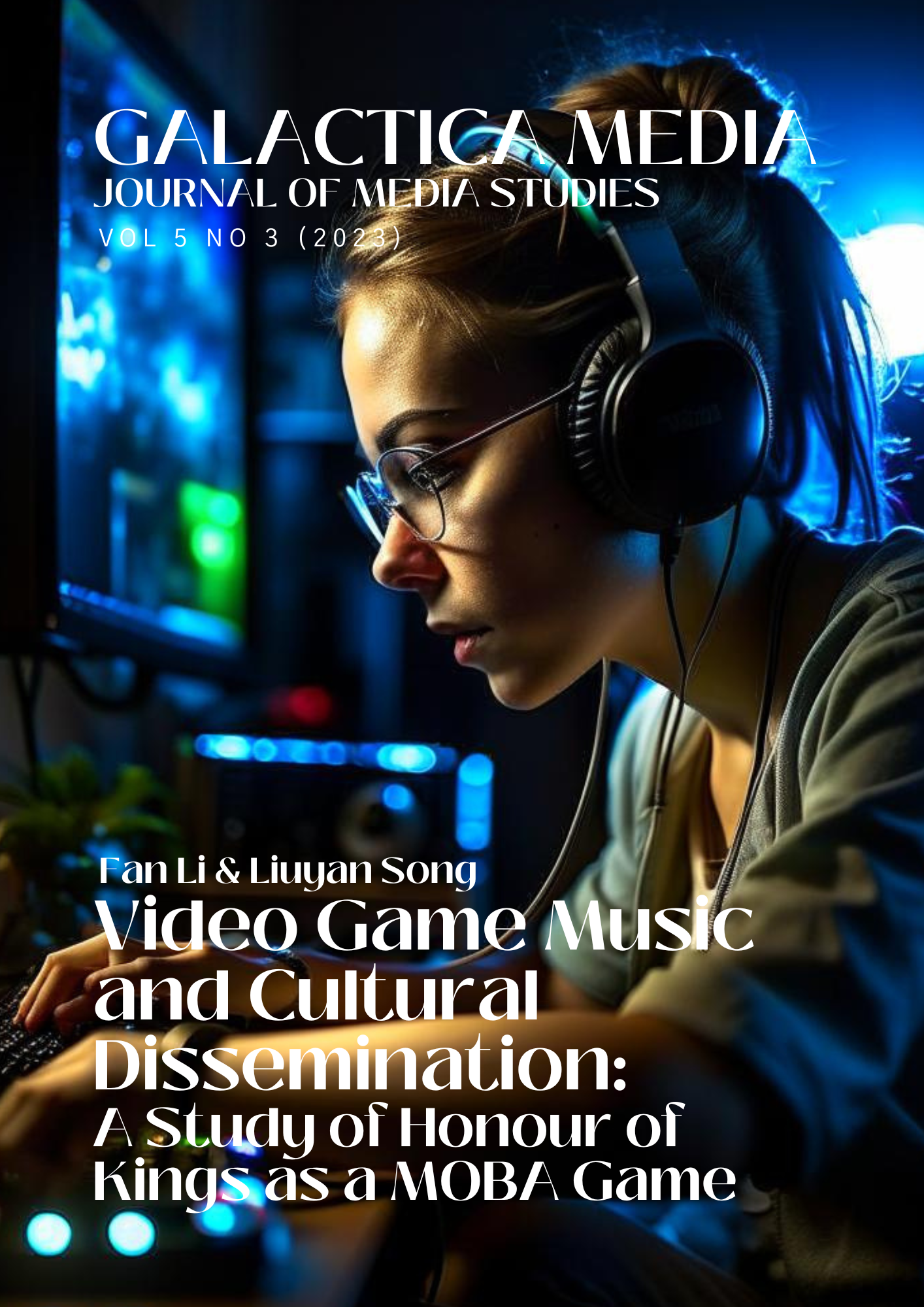Abstract
As the internationally one of the most-played multiplayer online battle arena (MOBA) game, Honour of Kings (HoK) has created a unique cultural phenomenon apart from its gaming appeal. HoK weaves its aesthetically-pleasing game character, plot, scene, background, and music with Chinese traditional culture (CTC) elements. This contributes to popularise CTC across the world and Chinese music works, accordingly. Therefore, this article starts with the CTC elements and music works in HoK and explores the effect of Video Game Music (VGM) on cultural dissemination. Further, it explores the new ways and trends of traditional culture transmission. Lastly, this article comprehensively discusses the current problems and solutions of cultural and musical promulgation in games. It can be explained that the effort in terms of VGM composition would contribute to the HoK game develop better. These findings can also provide research ideas for developing VGM in Chinese style.
References
Abbasi, A. Z., Rehman, U., Fayyaz, M. S., Ting, D. H., Shah, M. U., & Fatima, R. (2022). Using the playful consumption experience model to uncover behavioral intention to play Multiplayer Online Battle Arena (MOBA) games. Data Technologies and Applications, 56(2), 223–246. https://doi.org/10.1108/DTA-02-2021-0055
Bates, E., & Bennett, S. (2018). The production of music and sound: A multidisciplinary critique. In S. Bennett & E. Bates (Eds.), Critical approaches to the production of music and sound (pp. 1‑21). Bloomsbury Academic. https://doi.org/10.5040/9781501332074.0006
Cavanagh, R. (2020). Video game soundtrack albums and the digital revolution. In R. Cavanagh (Ed.), The soundtrack album: Listening to media (pp. 173–189). Routledge. https://doi.org/10.4324/9780429450488-15
Cayari, C. (2021). Popular practices for online musicking and performance: Developing creative dispositions for music education and the Internet. Journal of Popular Music Education, 5(3), 295–312. https://doi.org/10.1386/jpme_00018_1
Collins, K. (2013). Playing with sound: A theory of interacting with sound and music in video games. MIT press. https://doi.org/10.7551/mitpress/9442.001.0001
Donnelly, K. J., Gibbons, W., & Lerner, N. (2014). Transcribing musical worlds; or, is L.A. Noire a music game? In K. J. Donnelly, W. Gibbons, & N. Lerner (Eds.), Music in video games: Studying Play (pp. 77–103). Routledge. https://doi.org/10.4324/9781315882697
Hart, I. (2014). Meaningful play: Performativity, interactivity and semiotics in video game music. Musicology Australia, 36(2), 273–290. https://doi.org/10.1080/08145857.2014.958272
He, Y., & Choi, C. (2020). Analysis of visual art elements of game characters illustrated by the case of Glory of Kings. International Journal of Internet, Broadcasting and Communication, 12(3), 213‑219. https://doi.org/10.7236/IJIBC.2020.12.3.213
Jiang, Q., & Chung, J. H. (2021). A case study on the promotional animation of the mobile game ‘Honour of Kings’. Journal of Digital Convergence, 19(8), 293–299.
Juul, J. (2007). Swap adjacent gems to make sets of three: A history of matching tile games. Artifact: Journal of Design Practice, 1(4), 205–217. https://doi.org/10.1080/17493460601173366
Laine, T. H., & Suk, H. J. (2016). Designing mobile augmented reality exergames. Games and Culture, 11(5), 548–580. https://doi.org/10.1177/1555412015572006
Liboriussen, B., & Martin, P. (2020). Honour of Kings as Chinese popular heritage: Contesting authorized history in a mobile game. China Information, 34(3), 319–341. https://doi.org/10.1177/0920203X20908120
Marks, A. (2009). The complete guide to game audio: For composers, musicians, sound designers, and game developers. Taylor & Francis.
Meng, F., & Peng, Y. J. (2021). 文化融会与元素接合:《王者荣耀》的符号构建研究 [Cultural fusion and elemental engagement: A study of the symbolic construction of Honour of Kings]. 杭州师范大学学报(社会科学版) Journal of Hangzhou Normal University (Social Sciences Edition), 6, 92-101. (In Chinese).
Nuyens, F., Deleuze, J., Maurage, P., Griffiths, M. D., Kuss, D. J., & Billieux, J. (2016). Impulsivity in multiplayer online battle arena gamers: Preliminary results on experimental and self-report measures. Journal of Behavioral Addictions, 5(2), 351–356. https://doi.org/10.1556/2006.5.2016.028
Park, H. (2020). The Difficult, uncomfortable, and imperative conversations needed in game music and sound studies. Journal of Sound and Music in Games, 1(1), 87–94. https://doi.org/10.1525/jsmg.2020.1.1.87
Parsayi, F., & Soyoof, A. (2018). Video games: The interface between language learning and storytelling. International Journal of Pedagogies & Learning, 13(2), 103–118.
Shi, Y., & Chung, J. H. (2019). A study on the visual elements of the mobile game ‘Honour of Kings’ focused on female gamers. Journal of Digital Convergence, 17(9), 361–366.
Somerdin, M. (2016). The game debate: Video games as innovative storytelling. The Oswald Review: An International Journal of Undergraduate Research and Criticism in the Discipline of English, 18, 69–82.
Sun, M. Y. (2020). An analysis of the development of Chinese mobile games-Taking ‘Honour of Kings’ as an example. Digital Space, 10, 58–59.
Wang, Y. (2021). The application of integrated marketing communication in the marketing of the game industry. Lecture Notes in Education Psychology and Public Media, 1, 212–218. https://doi.org/10.54254/lnep.iceipi.2021201
Yao, S., & Chen, Y. (2022). Reconstructing history and culture in game discourse: A linguisticanalysis of heroic stories in Honor of Kings. Games and Culture, 17(7–8), 977–996. https://doi.org/10.1177/15554120211070890
Ye, D., Liu, Z., Sun, M., Shi, B., Zhao, P., Wu, H., Yu, H., Yang, S., Wu, X., Guo, Q., Chen, Q., Yin, Y., Zhang, H., Shi, T., Wang, L., Fu, Q., Yang, W., & Huang, L. (2020). Mastering complex control in MOBA games with deep reinforcement learning. 34(4), 6672–6679. https://doi.org/10.1609/aaai.v34i04.6144
Yu, L., Zhang, D., Chen, X., & Xie, X. (2019). MOBA-slice: A time slice based evaluation framework of relative advantage between teams in MOBA games. In T. Cazenave, A. Saffidine, & N. Sturtevant (Eds.), Computer Games (Vol. 1017, pp. 23–40). Communications in Computer and Information Science. https://doi.org/10.1007/978-3-030-24337-1_2
Zhang, Z., Li, H., Zhang, L., Zheng, T., Zhang, T., Hao, X., & Zhou, W. (2019). Hierarchical reinforcement learning for multi-agent MOBA game. ArXiv Preprint ArXiv:1901.08004. https://doi.org/10.48550/arXiv.1901.08004

This work is licensed under a Creative Commons Attribution 4.0 International License.


